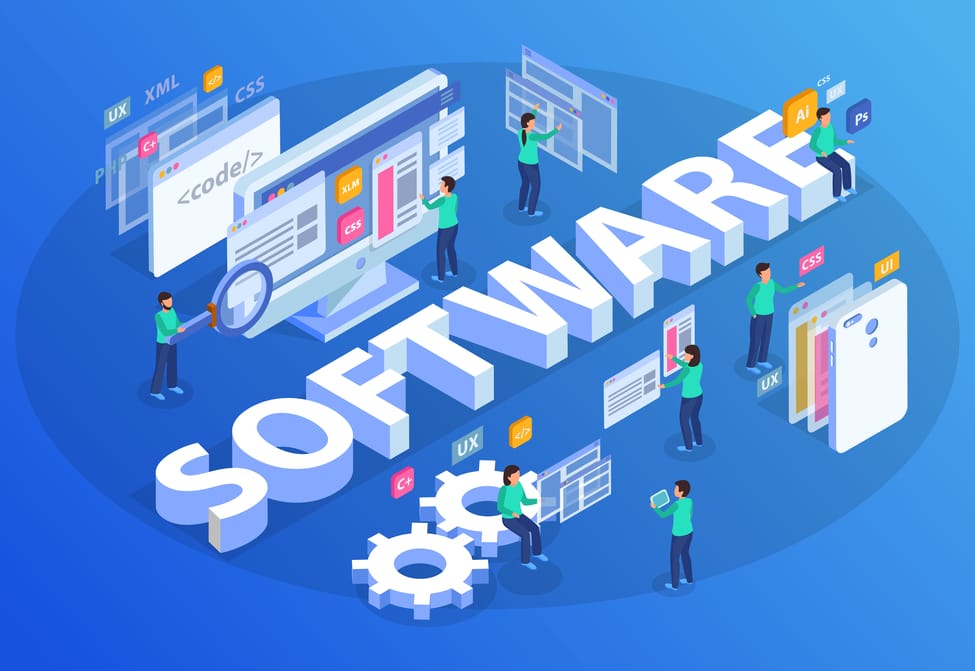In the 21st century, any software is considered to be a vital part of everyday routine, thanks to its high technological lifestyles and software developers. Nowadays, no action that is not fueled by certain processes is practically imaginable.
Table of Content:
• What is the job of the Software Development Team or Team Members?
• Steps to Successful Software Development
• Conclusion
Software development is a highly organised process, with exact protocols and carefully defined procedures. In addition to all other critical aspects, every time you require a complex system, software suite or Web-based user application or mobile application, a range of developments substantially depends.
Another factor is software development methodologies. They play a vital part in developing software. Custom software development companies use many methodologies for their day-to-day operations. There are certain advantages and disadvantages associated with each of them. The basic purpose of these software methodologies is to provide smooth software development according to the project requirements.
Coming back to basics, a collection of principles and methods, the software development life cycle helps link technical, non-tech team members and project players to develop your outstanding idea into a unique software product or solution.
It arranges the activity of the development teams so that the project requirements and timelines are met, and the budget remains. In each of the stages of the software development life cycle, a firm selects whether they are agile, waterfall, V models or RAD or incremental, depending on the software development process model.
Here we examine the most typical software development processes in order to learn how to start the perfect product.
• Steps to Successful Software Development
• Conclusion
Software development is a highly organised process, with exact protocols and carefully defined procedures. In addition to all other critical aspects, every time you require a complex system, software suite or Web-based user application or mobile application, a range of developments substantially depends.
Another factor is software development methodologies. They play a vital part in developing software. Custom software development companies use many methodologies for their day-to-day operations. There are certain advantages and disadvantages associated with each of them. The basic purpose of these software methodologies is to provide smooth software development according to the project requirements.
Coming back to basics, a collection of principles and methods, the software development life cycle helps link technical, non-tech team members and project players to develop your outstanding idea into a unique software product or solution.
It arranges the activity of the development teams so that the project requirements and timelines are met, and the budget remains. In each of the stages of the software development life cycle, a firm selects whether they are agile, waterfall, V models or RAD or incremental, depending on the software development process model.
Here we examine the most typical software development processes in order to learn how to start the perfect product.
What is the job of the Software Development Team or Team Members?
Software developers have significant challenges in developing and offering customer-friendly software that optimizes their business processes. There are various setbacks to avoid during the software development cycle, and the roadmap is often unclear. Often clients do not understand or grasp how they might utilise the inefficiencies in their own company process. This is largely the software developer's job.
A software developer, in typical instances, approaches a customer who is involved in an inefficient, expensive business process. The process flow is utilised for the management of a range of disputed tablets. Off-the-shelf software was tested but did not fit the company's special needs in a simplified, affordable way. This task can be successfully performed in certain steps.
A software developer, in typical instances, approaches a customer who is involved in an inefficient, expensive business process. The process flow is utilised for the management of a range of disputed tablets. Off-the-shelf software was tested but did not fit the company's special needs in a simplified, affordable way. This task can be successfully performed in certain steps.

Steps to Successful Software Development
1. Brainstorming and Planning
The initial or very first step in software development is brainstorming. Everything begins with a big idea. However, any proposal must be thoroughly considered to be put into practice. In order to achieve a new system in terms of company strategic objectives, resource availability, cost associated challenges, time frames and solutions, careful planning is the initial and one of the main phases of software development and product development. You will only be ready to move forwards after a perfect plan has been developed. You can significantly profit from a thorough plan from the start and all other tools phases.2. Analysis of Feasibility and Criteria
The project is specified in detail, and an examination of the viability of the project is done in this phase of software development.To create an operable solution, you need first to gain a more thorough understanding of the project goal and collect all the requirements for a clean code and a catchy concept.
The feasibility analysis shows all the technical and financial components of software development: time, materials and tasks, and team members' engagement figures help to calculate ROI and define cost and profits of projects.
Analysis of requirements also helps to identify the risks at the outset, in order to develop risk mitigation techniques from the start. Clear, structured documentation provides both the development team and the customers with greater cooperation and understanding.
For the subsequent successful phase in the software development cycle, analysing objectives and software performance is critical.
3. Design
A significant component in the product development cycle is software design.The true conceptualisation of the solution is generated during the design phase, which constructs the detailed software architecture to satisfy specific projects.
Setting certain workflows and standards, the custom design by the software architects and engineers includes defined overall solution/product design, database structure and design. The entire project framework is established in this phase utilising the last prototype and mockups used over the next phases.
This is a form of visual modelling of everything from the functionality of the solution to describing the core components of hardware, software tools, structural capabilities, processes in order to meet the needs of their businesses and the aims of the proposed solution. It is time to move towards development after the design has been identified.
4. Coding and Development
In this phase, the aim is to write code and transform design documentation into software in the process of software development. This is the most prolonged phase of the software development cycle as it is the skeleton of the whole approach and several factors and forces are essential. The software engineering/agile team must ensure that its codes comply with the requirements, the stakeholders' needs etc. However, the ready-to-use software will be required to meet the goals of the software project if the previous phases have been carefully completed. The development cycle releases come from alpha, beta and release candidates to construct real production. The testing step begins when the entire framework (DB, API, etc.) and planned solution functionalities are established.
5. Integration and Testing
The next phase of system testing and integration begins now that the software is constructed and completed. It may vary depending on the tests adopted. It's important to know the software testing life cycle process to make the most of it.However, QA engineers often employ a number of frameworks, together with prolonged unit testing, automation compilation and testing.
In order to guarantee that the code is clean and the business objectives of the solution are satisfied, the quality assurance (QA) team conducts a variety of tests, including functionality tests, systems integration and interoperability, as well as user acceptability testing etc.
Verification and validation play an essential role in assuring the effective completion of the application/solution. The implementation phase begins now that the software is bug-free.
6. Marketing and Operation
This is a step in which the manufactured solution is actually installed. The action plan is done step by step. The freshly constructed and tested app is moved into production, including the transfer of data and components, while only specific changes are implemented throughout the future versions. It could be an immediate release or a staggered release (in stages) if the project is more complex, depending on the complexity of the project. In fact, system developers and end-users can now view and test the finalised software.7. Operations and Maintenance
The final part of the software development life cycle comprises maintenance and frequent upgrades. The phase is addressed with serious efficiency since throughout the stage; the product is polished, updated, upgraded and fine-tuned according to the experienced developers on its performance. That’s exactly the right timing to robust the software features to update its performance and adapt per the genuine needs of the end-user, offer new capabilities or fulfil further user requirements.
8. Release it to the Customer for Testing
Meet the finalised product with the client and demo. Answer any queries and help the customer understand how the programme meets business requirements. A large number of clients have no knowledge of how to test software. If not all of the many screens and functionalities in the programme, let them go through most. Say to the customer, "attempt to break it." Most folks like this and are going to test it in further detail.Give users some configuration files if necessary, procedures to be taken for testing, to fuel the pump and to start. Set the customer to document bugs in a good way. Whenever an issue is detected, it is not a good method to send the developer an e-mail. Listing the developer quickly with a list of issues on the phone is not a good process. Have the customer record the flaws in software for bug tracking or even a tablet. Show them screenshots showing the condition and issue in the application. The documentation can be adjusted to reflect the correction as bugs are resolved.
9. Release to Production
The project is finished, and it's time to launch it. It will now control the business process of the customer. Try not to write down the customer's training material until they pay for such service in particular. Hire a hungry writer to accomplish that, even then. Writers are the key to make successful software development happen. The writing of training material should not waste good software development talents. Often, while the customer or some employees are testing, they would like to develop training materials. The application technology should be developed in advance for change.The user should, if possible, take all relevant training sessions before or shortly after release. Some bugs need to be resolved after release. It isn't better to succeed. Software projects are incredibly difficult to carry out smoothly, especially particularly large projects.
It's Time to Create the Software That Will Propel Your Company
In its systematic procedure, the Software Development Life Cycle differs between businesses to provide the best quality product that fulfils even the most demanding consumers' expectations. It's important to know that DevOps engineers should have architectural knowledge if you want to make sure your software development process is a success.In order to define precise activities to meet the unique objectives, the software development life cycle may be formed or altered to the needs of each specific project or application development or software provider. It is a model foundation for creating a context and equipping each team member active in technical and non-technical actions to produce, in particular, a code quality and a generally satisfactory solution that fulfils project requirements or governs decision making. At the end of the day, in order to make successful software development, the final product or solution is important, and while spending on the next excellent project, the consumer and the provider obtain collaboration in the world.
At Growth Hackers, we help businesses from all around the globe grow. Not only do we help them design high-converting landing pages, we also help them with other digital marketing strategies, data analytics, and conversion rate optimization. Contact Growth Hackers now if you want to design outstanding landing pages, generate leads and increase your revenue.




